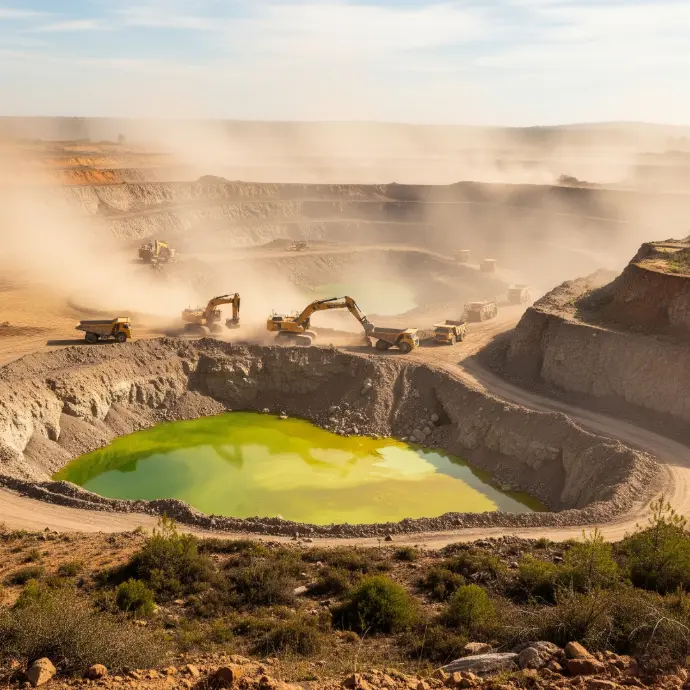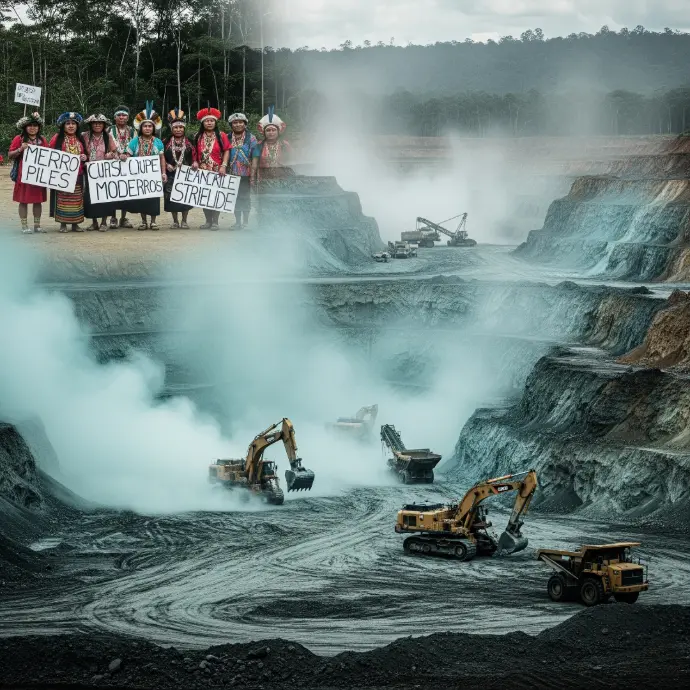Cyanide in Our Veins: The Impact of Hazardous Chemicals in the Mining Industry
Cyanide in Our Veins: The Impact of Dangerous Chemicals in the Mining Industry
Immerse yourself in a universe of detailed research and substantive reflection on the global implications of human rights. In our feature article, "Cyanide in Our Veins: The Impact of Dangerous Chemicals in the Mining Industry," we thoroughly explore the deeply damaging consequences these practices have on the most vulnerable communities and the ecosystem that surrounds them. Through a balanced yet powerful analysis, we uncover the complex dynamics behind this issue and its direct relationship to the struggle for dignity and the protection of fundamental rights. Join us as we examine the multiple facets of this troubling reality as we take the first step on an informative journey that confronts crucial questions and seeks answers. The search for the truth has only just begun.
Introduction
Mining plays an essential role in the global economy, providing the necessary materials for various industries, such as construction, technology, and manufacturing. Furthermore, this sector is a key source of employment in many parts of the world, positively impacting the economic development and quality of life of local communities.
The minerals and metals obtained from mines are essential in the creation of products we use daily, from cars to electronic devices, demonstrating the importance of mining in contemporary life. However, this favorable economic impact must be balanced by proper resource management and reducing the negative effects associated with mineral extraction.
It is essential to understand that, although mining is vital for economic growth, it can also have serious repercussions on the environment and public health if not carried out sustainably and safely.
Despite its economic value, mining has significant environmental impacts. The extraction of minerals and metals can result in soil degradation, contamination of water sources, and the release of hazardous gases, adversely affecting surrounding ecosystems. Furthermore, the operation of mining infrastructure, such as roads and platforms, can irreversibly transform the landscape.
The intensive use of water in mining activities can also deplete available water resources, impacting the water supply for local communities. Additionally, the production of mining waste and its improper management can pose a risk to biodiversity and public health.
Therefore, it is essential that mining companies implement sustainable practices and utilize innovative technologies to reduce these environmental impacts, protect biodiversity, and ensure the conservation of sensitive ecosystems.
In mining, hazardous chemicals, such as cyanide, are often used in mineral extraction processes, especially in the extraction of gold and silver. Although these substances are effective in separating metals from ore, they also pose serious dangers to the environment and human health.
Cyanide, in particular, is extremely toxic and can contaminate both soil and water if not managed properly. Cyanide spills can wreak havoc on aquatic ecosystems and be harmful to local fauna and flora. Furthermore, exposure to this substance can have severe effects on the health of mining workers and surrounding communities.
It is crucial that the mining sector adopt preventive measures, such as implementing safer processing technologies and properly managing chemical waste, to minimize the risk of contamination by cyanide and other harmful compounds. Furthermore, transparency and accountability are essential to ensure that mining activities are carried out carefully and with respect for the environment and human rights.
Rules and regulations in the mining sector are key to protecting the environment, the health of workers, and communities near mines. In many countries, specific laws govern the use of hazardous chemicals, such as cyanide, in mineral extraction. These regulations generally establish strict limits on the amount of cyanide allowed and protocols for handling and disposing of waste produced during the process.
In addition, regulations in the mining sector also address issues such as landscape restoration following resource extraction, compensation for affected communities, prior consultation with Indigenous communities, and transparency in mining activities. These regulations seek to balance mining operations with environmental protection and the rights of local populations, fostering a responsible and sustainable approach to mining.
It is important to note that the effectiveness of regulations and standards in the mining industry varies considerably across countries. Some nations have robust regulatory frameworks and effective oversight mechanisms, while in others, implementation and enforcement may be inadequate. This variability highlights the need for strong global standards and collaborative international action to ensure that mining, including the use of hazardous substances such as cyanide, is carried out safely and responsibly worldwide.

Legislation and Human Rights
International standards governing the use of hazardous chemicals in mining are essential for protecting human rights and the environment. In this context, it is important to mention the Basel Convention, which is responsible for controlling the movement of hazardous waste between countries and its disposal, with the goal of minimizing its production and monitoring its transfer. Furthermore, the Stockholm Convention addresses Persistent Organic Pollutants, establishing actions to eliminate or limit the creation and use of these compounds.
These global regulations aim to regulate the use of hazardous chemicals in mining, safeguarding both the health of mining workers and the communities living near mining areas, thus promoting respect for human rights and environmental protection.
It is vital that nations ratify and commit to comply with these international regulations to ensure a safe working environment and reduce the adverse impact of mining on communities and the natural environment.
Worker exploitation in the mining sector is a serious problem in many countries, where employees face poor working conditions, long hours, and the risk of exposure to substances such as cyanide. The lack of adequate regulation and oversight can result in the violation of essential labor rights, including the guarantee of a safe workplace, reasonable hours, and fair wages.
It is crucial that miners have fair and safe working conditions. Adopting safety protocols, training in the handling of hazardous substances, and respect for labor rights are key components to safeguarding the physical and mental health of workers in this industry.
Likewise, governments and mining companies must foster open communication with workers and their representatives to ensure their labor rights are respected and to effectively address any cases of exploitation.
Mining, especially when cyanide and other harmful chemicals are used, can have severe social consequences for adjacent communities. Contamination of water sources and soil, devastation of the local ecosystem, and human health problems are some of the direct repercussions of irresponsible mining.
Local communities are facing the loss of access to drinking water, as well as a decline in air and soil quality, which impacts their traditional ways of life. This can lead to social tensions, involuntary displacement, and a general deterioration in the well-being of the local population.
It is essential that mining companies be held accountable for minimizing and compensating for adverse effects on communities, as well as ensuring that they participate effectively and voluntarily in decisions that impact their environment. Likewise, governments must implement appropriate regulations and oversight mechanisms to safeguard the human rights of these communities and prevent mining-related conflicts.
Mining companies have an important obligation to protect human rights, especially in relation to the safety and well-being of their employees, as well as the effects their activities may have on neighboring communities and the environment. It is vital that these companies respect ethical and legal standards, ensuring respect for labor rights, workplace safety, and reducing the harmful impact on surrounding communities.
Likewise, mining companies must ensure that human rights violations do not occur at any stage of their operations, from extraction to the processing and sale of minerals. This requires the adoption of sustainable practices that protect both people and the environment, in addition to promoting transparency in their activities and accountability for incidents that affect human rights.
Mining companies are also responsible for including local communities in the decision-making process, respecting their independence, and ensuring that they obtain fair and equitable benefits from mining activities. This involves prior and informed consultation with impacted communities, as well as developing sustainability programs that promote the long-term well-being of these communities.

Conflicts and Challenges
Historically, the mining sector has faced disputes between mining companies, nearby communities, and environmental conservation organizations. This dispute escalates when hazardous chemicals such as cyanide are used in mineral extraction. Companies seek to increase profits and reduce costs, which frequently results in actions that threaten human health and the natural environment.
For their part, communities struggle to safeguard their health and protect their natural resources. The long-term threat posed by the presence of cyanide in water and soil is considerable for their well-being and their environment. This clash of interests has generated strong tensions and led to protests, lawsuits, and confrontations between the parties involved.
In this context, it is crucial to address the challenges of implementing sustainable practices in mining, with the aim of balancing the interests of mining companies, local communities, and environmental conservation.
Adopting sustainable practices in mining, especially regarding the management of toxic substances such as cyanide, entails multiple significant challenges. One major obstacle is the resistance to change among mining companies, which often prioritize short-term profits over environmental and public health concerns.
Another notable challenge is the lack of robust regulations and effective enforcement mechanisms. Current laws are often not stringent enough or are not properly enforced, allowing mining companies to avoid responsibility and operate without the necessary standards to protect the environment and surrounding communities.
Furthermore, the lack of clarity and accountability in the mining industry complicates the oversight and monitoring of the practices used. This creates favorable conditions for the irresponsible use of toxic chemicals, increasing the risk of pollution and damage to nature.
Conclusions
The importance of mining that is sustainable and respects human rights cannot be underestimated. Mineral extraction is vital to the global economy, but it must be carried out responsibly, considering its impact on local communities and the environment. Sustainable mining seeks to balance resource extraction with the defense of human rights and environmental conservation, which involves adopting cleaner technologies and safer methods.
In this context, it is essential that mining companies and governments work together to create rigorous regulations that safeguard human rights and the environment. The implementation of responsible extraction methods and effective oversight are important to ensure that mining does not cause harm to local communities or future generations.
Furthermore, it is crucial that civil society actively participate in monitoring and reporting potential human rights violations in the mining sector. Human rights groups and community-based collectives play a critical role in monitoring mining activities and denouncing harmful actions. Their work supports transparency and accountability and helps protect vulnerable communities from potential abuses.

 IHRO NEWS
IHRO NEWS